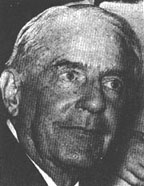God's Flesh
 |
| R. Gordon Wasson |
|
In May 1957, Life magazine ran a story on the discovery of the "magic mushroom" as
part of its Great Adventure series. Written by R.
Gordon Wasson, the seventeen-page spread, complete with color photos, was
laudatory in every way. Wasson, a vice-president of J. P. Morgan and Company, pursued
a lifelong interest in mushrooms as a personal hobby. He and his wife, Valentina,
journeyed all over the world, treading a unique path through the back roads of history
in an effort to learn about the role of toadstools in primitive societies. Their travels took
them to the remote highlands of Mexico, where they met a medicine woman who
agreed to serve them teonanacatl, or "God's flesh," as the divine mushrooms were
called. As he chewed the bitter fungus, Wasson was determined to resist its effects so as
to better observe the ensuing events. But as he explained to the readers of Life, his
resolve "soon melted before the onslaught of the mushrooms." Said Wasson: "We were
never more awake, and the visions came whether our eyes were opened or
closed....They began with art motifs, angular such as might decorate carpets or textiles or
wallpaper or the drawing board of an architect. They evolved into palaces with courts,
arcades, gardens, resplendent palaces all laid over with semiprecious stones....Later it
was as though the walls of our house had dissolved, and my spirit had flown forth, and
I was suspended in mid-air viewing landscapes of mountains, with camel caravans
advancing slowly across the slopes, the mountains rising tier above tier to the very
heavens....The thought crossed my mind: could the divine mushrooms be the secret
that lay behind the ancient Mysteries? Could the miraculous mobility that I was now
enjoying be the explanation for the flying witches that played so important a part in the
folklore and fairy tales of northern Europe? These reflections passed through my mind
at the very time that I was seeing the visions, for the effect of the mushrooms is to bring
about a fission of the spirit, a split in the person, a kind of schizophrenia, with the
rational side continuing to reason and to observe the sensations that the other side is
enjoying. The mind is attached as by an elastic cord to the vagrant senses." The visions
lasted through the night as Wasson lay on the floor of a tiny hut enraptured by God's
flesh. "For the first time," he wrote, "the word ecstasy took on real meaning. For the first
time it did not mean someone else's state of mind." Wasson's account constituted nothing less than a journalistic breakthrough. A mass audience was introduced to the mysterious world of chemical hallucinogens, and soon hundreds of people started flocking to Mexico to find their own curandero. At the same time Dr. Albert Hofmann conducted a chemical analysis of the divine mushroom at Sandoz Laboratories. He extracted the active ingredients and synthesized a new compound: psilocybin. Upon learning of Hofmann's achievement, the CIA immediately procured samples from Sandoz and forwarded the material to Dr. Harris Isbell at the Lexington Narcotics Hospital, where it was tested on drug addicts. |
An excerpt from Acid Dreams: The Complete Social History of
LSD: The CIA, the Sixties and Beyond, by Martin A. Lee and Bruce Shlain
(Grove Press)
Copyright 1985 by Martin A. Lee and Bruce Shlain
The Acid Dreams web site: http://www.levity.com/aciddreams/